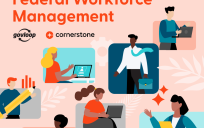If pandemic-induced telework has proven anything, it’s that civil servants can up their digital skills when they need to. They just need the right incentive and the right kind of agency support.
Organizations can’t force their employees to want to learn, nor can they control external circumstances that make them learn. But they can provide strong training content and support that makes learning and development less burdensome and more engaging.
“People want to be developed. They want to be developed in a way that means something to them, at the time of need. It’s important to the organization,” said Steve Dobberowsky, Senior Principal Consultant at Cornerstone, a talent management software provider.
In an interview with GovLoop, Dobberowsky spoke about how agencies can best provide learning opportunities and meet learning needs in a virtual environment.
Now: Virtual Training Fatigue
Virtual meeting fatigue is by now a working professional phenomenon, but the same phenomenon applies to online learning and development.
Some may assume that whatever training was done in the classroom, it can be converted online through a video conferencing platform and – voilà – it’s virtual instructor-led training. But that’s not the case, Dobberowsky said.
One problem is sensory deprivation. In a virtual environment, instructors can’t catch visual and nonverbal cues like they could in a classroom. That lack of interaction can be taxing, leading to the kind of fatigue that many people have experienced doing virtual meetings during remote work. Instructors need to find creative ways to engage participants and ensure that learning takes place. When training content is haphazardly dumped online, people won’t learn. They just get lost in the heaps of content, which is both a poor user experience and a lost learning opportunity.
To ensure engagement, agencies can use chat functions or breakout rooms for discussion. When possible, it’s best to take a blended approach, using both virtual and in-person training.
Later: An Agile and Comprehensive Strategy
In the long term, agencies need a better holistic and targeted talent management strategy. They should assess their learning needs as a whole to deliver modern, relevant and curated training content at the time of need. From there, agencies can figure out more specific solutions to engage and fill their learning needs.
In general, agencies need to become more agile in managing talent. To keep up with technology and find a balance between talent management initiatives, security and performance capabilities, agencies have to be able to adapt to the situation as needed, Dobberowsky said.
They also need to take a more comprehensive approach. Oftentimes, agencies deal with one need in talent management – for example, learning. But they then overlook other performance components or don’t pay attention to recruiting and onboarding. “All the pieces of talent management need to be dealt with collectively, holistically and in an agile manner,” Dobberowsky said.
This article is an excerpt from GovLoop’s recent report, “Upskilling and Reskilling the Workforce for the Future.” Download the full report here.





Leave a Reply
You must be logged in to post a comment.